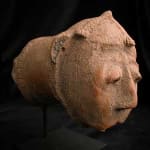Dakakari Sculpture of a Head, 16th Century CE - 18th Century CE
Terracotta
4.75 x 5
PF.5710 (LSO)
Further images
This unusual rendering of a human head was made by the Dakakari people. It is a remarkable piece, with a long, columnar neck ringed around with relief bands, and flaring...
This unusual rendering of a human head was made by the Dakakari people. It is a remarkable piece, with a long, columnar neck ringed around with relief bands, and flaring towards the broken distal end. The head is oval in form and lugubrious in expression, with a crown-like coiffure, protuberant, downcast eyes, a long, crest-like nose and a small mouth, The face is textured with vertical combing. The breakage and the orientation of the neck and face indicate that this was originally part of a larger vessel, as explained below. It was thus probably an ornamental handle.
The Dakakiri people of NW Nigeria are a little-studied group that is primarily known for their unusual funerary traditions. The standard practice was to bury individuals with a range of plain pottery for their use in the afterlife. However, it is the burials of the higher status individuals from the tribe – including their chiefs and their retinue – that give rise to the production of the Dakakiri’s major contribution to the corpus of African art history. Prestige individuals are buried in stone-lined shaft tombs; the sealed tops of these tombs are ringed around with stone walls to create a small enclosure.
Skilled potters are then commissioned to create sculptural vessels, with plain, spherical bases that are buried into the underlying soil, and with anthropomorphic or zoomorphic superstructures that commemorate the deceased. The deceased are venerated annually by pouring libations of maize flour or beer over the pots. The trade was usually kept within families; experience was all-important – the most prestigious potters were often post-menopausal women. Every person who dies in an elite family has another piece – or pieces – dedicated to them and placed within the superstructure over time, these collections can build up considerably, marking the development of the family throughout generations.
The identity of the person portrayed will be connected either directly to the deceased for whom it was made, or represent a mythical or legendary character from Dakakari history. It is likely to have performed some ritual of even just affectionate function for the dead. This is a rare and important piece of African art.
The Dakakiri people of NW Nigeria are a little-studied group that is primarily known for their unusual funerary traditions. The standard practice was to bury individuals with a range of plain pottery for their use in the afterlife. However, it is the burials of the higher status individuals from the tribe – including their chiefs and their retinue – that give rise to the production of the Dakakiri’s major contribution to the corpus of African art history. Prestige individuals are buried in stone-lined shaft tombs; the sealed tops of these tombs are ringed around with stone walls to create a small enclosure.
Skilled potters are then commissioned to create sculptural vessels, with plain, spherical bases that are buried into the underlying soil, and with anthropomorphic or zoomorphic superstructures that commemorate the deceased. The deceased are venerated annually by pouring libations of maize flour or beer over the pots. The trade was usually kept within families; experience was all-important – the most prestigious potters were often post-menopausal women. Every person who dies in an elite family has another piece – or pieces – dedicated to them and placed within the superstructure over time, these collections can build up considerably, marking the development of the family throughout generations.
The identity of the person portrayed will be connected either directly to the deceased for whom it was made, or represent a mythical or legendary character from Dakakari history. It is likely to have performed some ritual of even just affectionate function for the dead. This is a rare and important piece of African art.









